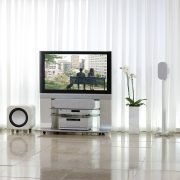Listen To Your Speakers
Hearing is subjective, meaning not everyone perceives sound the same way. What sounds slightly shrill or bright to one person may be revealing and airy to another, so there is always going to be room for debate over which speaker sounds best. When choosing a speaker, sound quality is ranked among appearance, size, budget, room dimensions and several other factors, so it’s not always as simple as what sounds best.
This article focuses on the audible aspects of choosing a speaker and what to consider when answering the question, “What is the Best Sounding Speaker for Me?” The characteristics listed below are the top priorities for Platinum Vision when designing and installing loudspeakers. We’re passionate about creating sound that is a true reflection of the nuance, artistry and intensity of your favorite music, movies, games, and all audio content.
Clarity
The easiest and most objective thing to listen for is clarity. One way to determine whether a speaker has excellent clarity is to play music you are familiar with, a song or album where you know every note, beat and detail. Are you hearing those details cleanly and clearly? Better yet, are you noticing sounds or layers you have never heard before because the speakers are so revealing? These are the tell-tale signs of a speaker with great clarity.
On the flipside, if the details sound muffled or muddy and the sound is not as expressive as you remember, it is not the best sounding speaker for you.
Imaging & Soundstage
The second thing to listen for in a stereo or home theater system is imaging and soundstage, or the ability to render a sense of place, distance and a three-dimensional sound field. Speakers should convince you there is sound coming from all around, not just from two boxes in front of you. The bass guitarist should be distinguishable from the lead singer and drummer in terms of location onstage when listening to live music. A car racing in front of you should get louder and softer as it goes from right to left or vice versa so you believe it’s zooming across your field of vision.
Soundstage also refers to a speaker’s ability to create atmospheric sound. Even the background noises behind dialogue or action scenes are clearly perceptible and deepen the sense of immersion.
Neutrality & Refinement
Neutrality and refinement refer to a speaker’s ability to sound as close to the real thing as possible. Does a human voice sound exactly like a human voice, or more robotic? Does the pluck of a guitar string, the roar of an engine, or the soft vocals of a female vocalist come through accurately and faithfully to how the original artist or producer intended?
Since the majority of dialogue and instrumental content occurs in the mid-range frequencies, it’s especially important to focus your listening there, but don’t ignore bass and high frequencies for their ability to recreate the full impact and power in a convincing and realistic way. If a speaker can suspend your sense of disbelief and transport you onstage or to the middle of a movie scene, it has superb neutrality and refinement.
Dynamic Range
A speaker’s ability to effortlessly rise to extreme musical and cinematic peaks or to render the quietest moments with detail and clarity is known as its dynamic range. It’s not just a measure of how loud you can crank the speaker with minimal or no distortion, dynamic range is more nuanced than that. The better question to ask is, how well does the speaker show the contrast between the loudest and quietest moments in your content? You want a speaker that can play as loud as you need it to, but that can also be subtle or delicate when the content demands it.
When it comes to choosing a speaker based on sound, you won’t go wrong by listening for the qualities mentioned above. If you love the sound based on these criteria, love the appearance, it fits within the dimensions of your listening room and is priced within your budget, you’ve most likely found the perfect speaker for you.
If you still have thoughts or questions about how to choose the right speakers, write to us at info@pv.ae and our technical team will be happy to assist?




